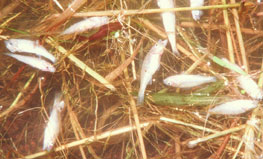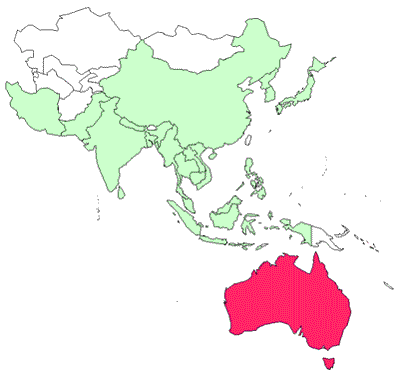Diseases of finfish
Viral diseases—Epizootic haematopoietic necrosis
CLICK ON IMAGE TO ENLARGE

Source: anonymous
CLICK ON IMAGE TO ENLARGE

Source: anonymous
Signs of disease
Important: animals with disease may show one or more of the signs below, but disease may still be present in the absence of any signs.
Disease signs at the farm level
- typically many (hundreds or thousands) of small fish less than 10 cm long found on downwind bank of water body
- large numbers of fish-eating birds (eg seagulls) at water surface.
Disease signs at the tank or pond level
- fish cease feeding
- juveniles (<25 mm) often swimming in disorientated fashion at surface
- adults may also be affected when the disease first arrives in an area.
Clinical signs of disease in an infected animal
- distended abdomen
- darkened skin colour
- petechial (pinpoint) haemorrhages at base of fins
- haemorrhaging of the gills.
Gross signs of disease in an infected animal
- swollen kidney and spleen.
Disease agent
Epizootic haematopoietic necrosis (EHN) in Australia is caused by epizootic haematopoietic necrosis virus (EHNV), a systemic iridovirus (ranavirus).
Related viruses are responsible for causing the same disease in sheatfish and catfish in Europe (European sheatfish virus and European catfish virus).
In this guide, only EHN due to EHNV is discussed.
Host range
Fish known to be susceptible to EHN:
rainbow trout* (Oncorhynchus mykiss)
redfin perch* (Perca fluviatilis)
Macquarie perch (Macquaria australasica)
mosquito fish (Gambusia affinis)
mountain galaxias (Galaxias olidus)
silver perch (Bidyanus bidyanus)
* naturally susceptible (other species have been shown to be experimentally susceptible)
Presence in Asia–Pacific

EHN has been officially reported from Australia.
Epidemiology
- EHN is usually seen in Australia as large kills of small redfin perch, but mortality also occurs among older perch.
- Clinical outbreaks are associated with poor water quality, and water temperature between 11°C and 17°C in rainbow trout and above 12°C in redfin perch.
- Kills occur over a short period (several weeks) in summer, and then the disease may disappear from an area for years.
- Low mortalities over a period of months have been reported in young farmed rainbow trout.
- Infectivity is less severe in rainbow trout, mainly affecting fingerlings <125 mm long.
- Low-grade mortalities with covert EHNV infection can also occur in grower fish. Therefore, care must taken when moving redfin perch and rainbow trout from the known geographical range of EHNV to areas where it is exotic, unless freedom can be adequately documented.
- Low prevalence of antibodies in naturally infected trout suggests a very low prevalence of carrier status in farmed trout.
Differential diagnosis
The differential diagnostic table and the list of similar diseases appearing at the bottom of each disease page refer only to the diseases covered by this field guide. Gross signs observed might well be representative of a wider range of diseases not included here. Therefore, these diagnostic aids should not be read as a guide to a definitive diagnosis, but rather as a tool to help identify the listed diseases that most closely account for the gross signs.
Similar diseases
Viral haemorrhagic septicaemia, infectious haematopoietic necrosis
Sample collection
Because of uncertainty in differentiating diseases using only gross signs, and because some aquatic animal disease agents might pose a risk to humans, you should not try to collect samples unless you have been trained. Instead, you should phone your national hotline number and report your observations. If samples have to be collected, the agency taking the call will advise you on what you need to do. Local or district fisheries/veterinary authorities could advise you on sampling.
Emergency disease hotline
For your national emergency disease hotline number, see Whom to contact if you suspect a disease.
Further reading
http://www.oie.int/aac/eng/cards/en_diseasecard.htm
The currently accepted procedures for a conclusive diagnosis of EHN
are summarised at
http://www.oie.int/eng/normes/fmanual/A_00018.htm
These hyperlinks were correct and functioning at the time of publication.

